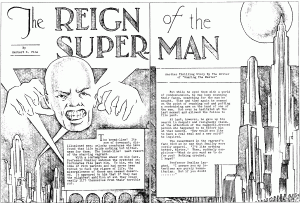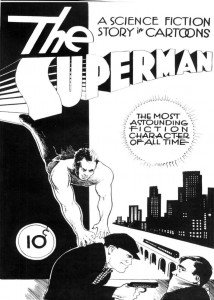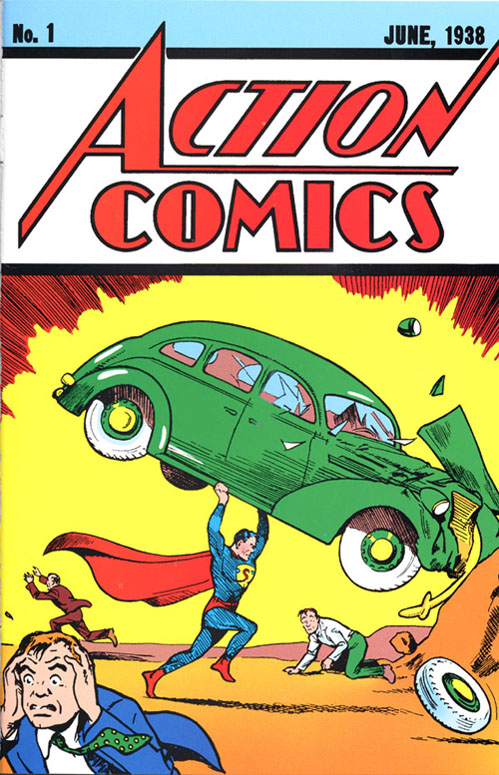In this month’s Sequential History, we’re going to look back at the beginning. The beginning, some believe, of the comic book as we know it. Back to the first “superhero” of his kind to gain real popularity, Superman. The refugee from Krypton was cooked up by Jerry Siegel and Joe Shuster in the 1930s.
Love him or hate him, he was the first real force of his kind, a costumed superhero with super powers, to appear in a comic book. Debuting in his current form in June of 1938 in Action Comics #1, he predates Batman by 11 months, and plenty of others who followed in 1940 & 1941. Some of the characters to follow Superman are Captain America, Namor, the original Human Torch, The Flash, Wonder Woman and Captain Marvel to name a few. All of these characters debuted within three & a half years of Action Comics #1‘s publication. How much influence did Superman have in their creation and development? How much influence did he have on the medium in general?
The Creators

Superman was created by Jerry Siegel and Joe Shuster in the 1930s. I say the 1930s because the character evolved over the course of several years. He was originally a very different character from the one we know today as Superman, but we’ll get to that later. Strangely, perhaps only to me, these two will be the first creators I’ve written about that aren’t from New York. Both Siegel and Shuster grew up in Cleveland, OH, where they met in high school.
When Joe and I first met, it was like the right chemicals coming together. — Siegel, on meeting Shuster
These two made a good team, with Siegel as the writer, and Shuster handling the artwork.
Jerome Siegel was born in Cleveland, Ohio, in 1914. Known as a shy kid, he didn’t have the greatest beginning in life. His father, who encouraged his son’s talents, was murdered during a robbery at his haberdashery store while Jerry was in junior high. It was just a few years after this tragedy that the idea for a bulletproof Superman came to Siegel.
Was Superman’s creation driven by the murder of Siegel’s father? Maybe influenced a little bit by it?
Siegel worked on his high school paper, The Torch, and was a fan of all kinds of comics and science fiction. It was during that time, while Siegel was still a young man, that the idea for Superman first came to be. However, this character from so long ago was a completely different hero from the Superman we have today. You might be surprised to know what that young man originally came up with. Siegel however, isn’t the whole story. As the story goes, Siegel thought up the idea for a superman while relaxing at home as a teenager, and immediately ran over to his friend Shuster’s house. Together, they created Superman.
Joe Shuster, born in Toronto, grew up in Cleveland and attended high school there with Siegel. Together, he and Siegel would publish a few science fiction fanzines. They were produced on a typewriter and advertised in the classified section of another science fiction magazine, Science Wonder Stories. The two friends had a few things in common. Foremost among these was their interest in comics. Shuster had a hobby of sketching, which would serve him very well later in life. Some of his work from back then still looks amazing, and just as eye catching as the best of today’s work.
Over the years, Siegel wrote under a few different names, including Jerry Siegel (the name credited with co-creating Superman), Herbert S. Fine, Joe Carter and Jerry Ess. He and Shuster went on to do some pretty memorable work, before their collaboration in Action Comics. They got their start in the business with the breakthrough comic book New Fun, which was the first to feature original material as opposed to reprinting comic strips from newspapers. It was also the first book to be published by the company that would eventually become DC Comics. In New Fun #6 (October 1936) they created Dr. Occult, a supernatural crime fighter who’s still active in DC Comics today. Quite an accomplishment for two young men delving into a relatively young medium. They continued on working for various publishers, on different titles, until Superman debuted.
Superman is born

So, what was Superman like when he was first dreamt up by Siegel and Shuster? Well, the first time he was put down on paper and published, he was bald, evil, and imbued with crazy strong mental powers. This guy would have made the powerful telepaths of today’s comics look like chumps. He had telepathic power on a planetary scale, and unlike our Superman of today, this guy was human.
Siegel wrote, under the pseudonym Herbert S. Fine, and Shuster illustrated, The Reign of the Super-Man in 1933. This was the version of Superman that this duo originally created. Found in Science Fiction, the Advance Guard of Future Civilization #3 (published by Siegel & Shuster) this Superman didn’t gain popular acclaim, and wasn’t heard from again. Keep in mind, that Action Comics #1 was still a good 5 years from being published.
The Superman of this 1933 story was given telepathic powers by an evil scientist who secretly experimented on Bill Dunn, a man he found in a bread line. After the experiment proved successful, Dunn decided to rule the world with his newfound abilities.
The story isn’t half bad, and can be found in its entirety online. I’ll refrain from spoiling the ending for you, but I will tell you that it’s worth your time to check out this very cool bit of comic history.
Superman’s next evolutionary stage


After the 1933 story, Superman received a makeover. When you look at this version of Supes, you can start to see a resemblance to our modern era Man of Steel. Siegel and Shuster both compared this Superman to Slam Bradley, a character that they had created in Detective Comics #1 (March 1937). This version of Superman never really appeared in a story, or in any published work. Siegel had written a story, which, perhaps out of discouragement, he later destroyed, and Shuster worked his magic on the covers. Apparently all that remains of this Slam Bradley-like Superman are the two cover sketches that Shuster put together. The major change that occurred with this version of Superman is that he is now a hero, fighting for the downtrodden. Superman went through some changes, but was still unknown to the comic book reading public.
Siegel and Shuster continued to refine their Superman. They shopped him around to publishers, but got no bites. Then an illustration of Shuster’s ended up in a desk drawer at National Comics in New York. This image was eventually fished out and slapped on the cover of Action Comics #1. After choosing the cover, they contacted the boys from Cleveland for a story to stick in the issue. And the rest is sequential history.

Superman’s Influence
The influences of Superman on comics over the past 70 years is something I’m not going to try to quantify here. Needless to say, Clark Kent’s secret identity has impacted a lot of people. He has also spawned other characters, some outright copies, some not so much. Let’s take a look at some of what Siegel and Shuster’s creation has nudged along.
Batman
Batman was created after Superman was introduced to the public. Superman’s success had editors, including Bob Kane’s, calling for super heroes from their creative teams. This really drove a lot of competitive creating back then to get their piece of the super hero pie. For an example of just how successful Superman was, let’s look at some numbers. Siegel and Shuster were reported to have been bringing in around $75,000 a year, each. That was 70 years ago. Batman creators Kane and Bill Finger were under pressure, as were most creators of that time, to turn out a super hero to try to cash in on the sales that Superman was gaining. In addition to the pressure, there was the salary difference between the super hero work that Siegel and Shuster were doing, and the humor comics that many others were producing. Before Batman took off, Kane was making around $25 per week, compared to Siegel and Shuster who were bringing in $1500. Shortly after Superman, Batman came into existence in the pages of Detective Comics. This is not really a unique case, as many characters were created a short time after Superman was introduced to the public. Superman’s success spurred on the creation of many characters in the early forties.
Would we have Batman without Superman? How different would things be on the comic landscape if we didn’t have Batman?
Captain Marvel
Captain Marvel, as in Shazam!, was introduced in February of 1940 by Fawcett Publications. This company had decided in 1939 that it needed to form a comic book division to capitalize on the popularity of the new medium. The popularity of comic books at that time can be traced to Superman. Shortly after the decision to enter the comics business is made, they introduced Captain Marvel. During the 1940s, Captain Marvel would go on to outsell Superman, becoming the most popular character of the decade. The Marvel family has had a huge impact on the DC Comics universe over the years.
Was Captain Marvel a copy of Superman? This issue was brought before the courts, and in 1953, Fawcett settled, and ceased publishing Captain Marvel stories. Apparently the Captain reminded the folks over at DC a little too much of Superman.
Copies of Superman
There are several characters that appear to be copies of Superman, altered just enough to get by legally, and others whose powers seem to be based on Superman’s. Some that come to mind are Marvel’s Hyperion, Sentry, and Gladiator. These aren’t shallow, empty rip-offs of DC’s flagship hero. They are interesting, richly developed characters who can carry a story all by themselves.
Super Heroes
Superman pretty much began the super hero genre of comics. There were heroes before him, but none became as successful as the Kryptonian. Super hero books dominate our American comic market. Would that be the case without Superman? What about other genres?
Horror comics became popular in the years following the initial super hero boom of the late 1930s / early 1940s. Would horror comics have become even more popular if there was no competition from the super heroes? If the horror books had become the dominant type of comic, would Dr. Wertham have succeeded in his efforts to stop comic books from corrupting the minds of young people? Would the flood of horror books have made it easier for him to influence Congress to clamp down on the creativity of comic creators? Would every comic we read today have to come from the underground?
I think a hero is an ordinary individual who finds strength to persevere and endure in spite of overwhelming obstacles. — Christopher Reeve
The Back Cover
I think all of us who enjoy comics do so, at least in some small part, thanks to the success that Superman has enjoyed over the 70 years since his introduction. Thanks goes to those two teenage boys who gave us the most recognizable character in comics, perhaps in all of fiction, that the world has ever known.
Resources
The Reign of the Super-Man Part 1 | Part 2 | Part 3 | Part 4 | Part 5 | Part 6 | Part 7 | Part 8
The house where Jerry Siegel created Superman (Be warned, you may get choked up)
Current state of Siegel’s childhood home
Eli Anthony
eli@comicattack.net




Great article Eli. You ask a lot of intriguing questions, ones that we can only hypothesize about, but one thing is definitely clear: Superman is the man responsible for the industry being where it is today!
Like it or not, SuperMan is responsible for the success of comics. Period. I like the character, ingeneral and in animation but not really in comic book format. Weird huh?
Oh, and good article Eli!
Fantastic article man! i’ve wondered a few times how comics would be if Supes hadn’t been as successful. Its amazing how much has happened in the industry these past 70 yrs and with the character they created! thanks for the historical tidbit Eli.
Pingback: Sequential History: The Platinum Age (1897 – 1938)